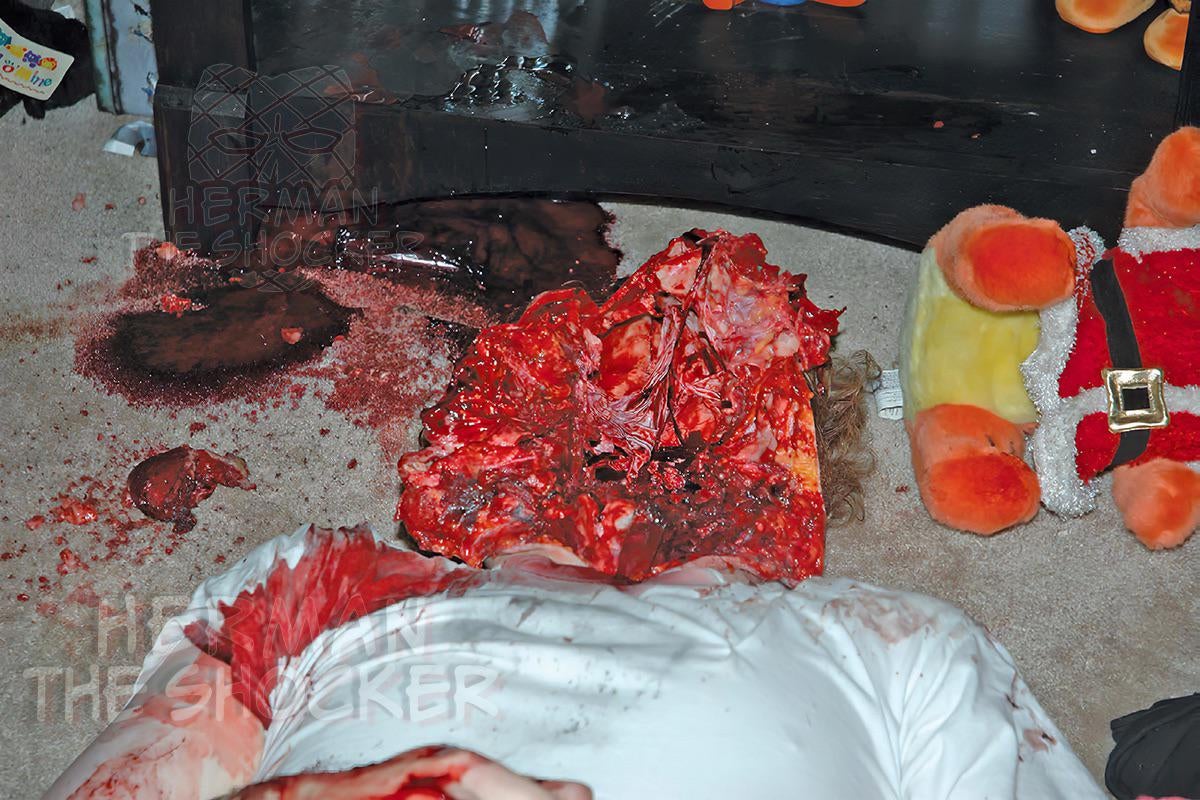This victim shot himself under the chin with a shotgun creating this classic massive tissue destruction. No further info. Head injuries from shotguns and high-powered rifles are typically quite devastating, often with extensive soft tissue destruction, skull fractures, and pulpifaction of the brain. Occasionally, the brain is largely expelled from the cranial vault and may be found near the body. Self-inflicted submental and transoral wounds may produce serious but survivable brain injuries if the path of the bullet is limited to the frontal area.
Shotgun pellets are poor ballistically because being round they present more surface area increasing drag. At close range, the shotgun is the most formidable and destructive of all small arms. For birdshot and buckshot loads, the severity and lethality of a shotgun wound depends on the number of pellets that enter the body, the organs struck by the pellets, and the amount of tissue destruction. Typically, these wounds are jagged, irregular lacerations with everted edges and bone fragments under the skin.
In the head, neck, and limbs, shotgun exit wounds can be ragged and very large, with extensive tissue damage. In a suicide where the gun has been placed in the mouth, there will be significant disruption of the head, and brain may be expelled, the so-called “burst head” effect.
The head is the most common location for a suicidal shotgun wound (74%), followed by the chest (20%) and then the abdomen (6%). In head wounds, the most common location was intraoral (50%), followed by under the chin (19%); side of head, including parietal and temporal wounds (15%); and the face, including the forehead (13%).
In the case of homicides, 59% occurred at a distant range, 21% occurred at an inter-mediate range, and 8% were at contact range. There was not a significant most common location for homicidal shotgun wounds, though the head, chest, and multiple locations all occurred about 25% of the time, representing the three most common locations. The most common locations of wounds to the head were face, including forehead (37%), and the side of the head, including parietal and temporal wounds (23%). (Molina et al. 2007).
Shotguns differ from rifles and handguns in construction, ammunition, ballistics, and use. Rifles and handguns fire a single projectile down a rifled barrel. Shotguns have a smooth bore. Although they can fire a single projectile, they are usually employed to fire multiple pellets. Rifled shotgun barrels, intended for use with slugs, are available. Shotguns may be autoloaders, pump (slide action), over/under, side-by-side, bolt action, or single shot. Some shotguns usually intended for military and/or police use convert from semiautomatic to pump action and back as the user desires.
Latest posts







 US ☎︎ 988 or 1-800-273-TALK (8255)
US ☎︎ 988 or 1-800-273-TALK (8255) CA ☎︎ 1-833-456-4566
CA ☎︎ 1-833-456-4566 UK ☎︎ 0800-689-5652
UK ☎︎ 0800-689-5652 AUS ☎︎ 13-11-14 or 1300-659-467
AUS ☎︎ 13-11-14 or 1300-659-467 ROK ☎︎ 1393
ROK ☎︎ 1393 DE ☎︎ 0800-111-0-111
DE ☎︎ 0800-111-0-111 ES ☎︎ 024
ES ☎︎ 024





